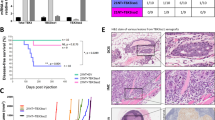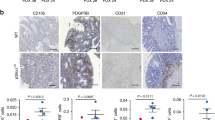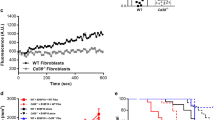Abstract
FGF-1 and FGF-2 are pleiotropic growth factors for many cell types, operating through the activation of specific transmembrane FGF receptors (FGFRs). The role of these factors in tumor progression was investigated, with specific discrimination between their autocrine and non autocrine cellular activity. The rat bladder carcinoma NBT-II cells were engineered to produce FGF-1 or 18 kDa FGF-2 in the presence or absence of their specific receptor. Non-autocrine cells that produced FGF-1 or FGF-2 but lacked FGFRs were epithelial and reminiscent of the parental NBT-II cells. Whilst autocrine cells, which both constitutively produced and secreted the growth factor and expressed FGFRs, had a highly invasive mesenchymal phenotype. Correspondingly, the autocrine cells were highly tumorigenic in vivo compared to the parental and non-autocrine cells, which correlated with the increased production of uPAR and active uPA and increased in vitro invasive potential. Although all cells produced VEGF, only tumors derived from cells that produced FGF-1 or FGF-2 were highly vascularized, suggesting that these two growth factors could be involved in the angiogenic process by activating host endothelial cells. As a result of activation of the FGFR in autocrine cells, changes in cell morphology and an increase in the invasive and tumorigenic properties were observed, however no in vitro or in vivo differential functions between FGF-1 and FGF-2 could be identified in this system. In conclusion, our data demonstrates that rapid tumor development is not dependent upon increased tumor vascularization, suggesting that ‘basal’ angiogenesis, probably mediated by VEGF, is sufficient to support tumor growth.
This is a preview of subscription content, access via your institution
Access options
Subscribe to this journal
Receive 50 print issues and online access
$259.00 per year
only $5.18 per issue
Buy this article
- Purchase on Springer Link
- Instant access to full article PDF
Prices may be subject to local taxes which are calculated during checkout







Similar content being viewed by others
References
Andreasen PA, Kjoller L, Christensen L, Duffy MJ . 1997 Int. J. Cancer 72: 1–22
Bajou K, Noel A, Gerard RD, Masson V, Brunner N, Holst-Hansen C, Skobe M, Fusenig NE, Carmeliet P, Collen D, Foidart JM . 1998 Nat. Med. 4: 923–928
Basilico C, Moscatelli D . 1992 Adv. Cancer Res. 59: 115–165
Bergers G, Brekken R, McMahon G, Vu TH, Itoh T, Tamaki K, Tanzawa K, Thorpe P, Itohara S, Werb Z, Hanahan D . 2000 Nat. Cell Biol. 2: 737–744
Bergers G, Coussens LM . 2000 Curr. Opin. Genet. Dev. 10: 120–127
Boilly B, Vercoutter-Edouart AS, Hondermarck H, Nurcombe V, Le Bourhis X . 2000 Cytokine Growth Factor Rev. 11: 295–302
Borgfeldt C, Hansson SR, Gustavsson B, Masback A, Casslen B . 2001 Int. J. Cancer 92: 497–502
Chang C, Werb Z . 2001 Trends Cell Biol. 11: S37–S43
Claffey KP, Abrams K, Shih SC, Brown LF, Mullen A, Keough M . 2001 Lab. Invest. 81: 61–75
Compagni A, Wilgenbus P, Impagnatiello MA, Cotton M, Christofori G . 2000 Cancer Res. 60: 7163–7169
Dano K, Romer J, Nielsen BS, Bjorn S, Pyke C, Rygaard J, Lund LR . 1999 Apmis 107: 120–127
Fang J, Shing Y, Wiederschain D, Yan L, Butterfield C, Jackson G, Harper J, Tamvakopoulos G, Moses MA . 2000 Proc. Natl. Acad. Sci. USA 97: 3884–3889
Florkiewicz RZ, Majack RA, Buechler RD, Florkiewicz E . 1995 J. Cell Physiol. 162: 388–399
Forough R, Xi Z, MacPhee M, Friedman S, Engleka KA, Sayers T, Wiltrout RH, Maciag T . 1993 J. Biol. Chem. 268: 2960–2968
Gately S, Tsanaclis AM, Takano S, Klagsbrun M, Brem S . 1995 Neurosurgery 36: 780–788
Giavazzi R, Giuliani R, Coltrini D, Bani MR, Ferri C, Sennino B, Tosatti MP, Stoppacciaro A, Presta M . 2001 Cancer Res. 61: 309–317
Giri D, Ropiquet F, Ittmann M . 1999 Clin. Cancer Res. 5: 1063–1071
Hernandez-Barrantes S, Toth M, Bernardo MM, Yurkova M, Gervasi DC, Raz Y, Sang QA, Fridman R . 2000 J. Biol. Chem. 275: 12080–12089
Jaye M, Lyall RM, Mudd R, Schlessinger J, Sarver N . 1988 EMBO J. 7: 963–969
Jouanneau J, Gavrilovic J, Caruelle D, Jaye M, Moens G, Caruelle JP, Thiery JP . 1991 Proc. Natl. Acad. Sci. USA 88: 2893–2897
Jouanneau J, Plouet J, Moens G, Thiery JP . 1997 Oncogene 14: 671–676
Jouanneau J, Moens G, Thiery JP . 1999 Oncogene 18: 327–333
Kinoshita T, Sato H, Okada A, Ohuchi E, Imai K, Okada Y, Seiki M . 1998 J. Biol. Chem. 273: 16098–16103
Lehti K, Lohi J, Valtanen H, Keski-Oja J . 1998 Biochem. J. 334: 345–353
Maatta M, Soini Y, Liakka A, Autio-Harmainen H . 2000 Clin. Cancer Res. 6: 2726–2734
Mazzieri R, Masiero L, Zanetta L, Monea S, Onisto M, Garbisa S, Mignatti P . 1997 EMBO J. 16: 2319–2332
McCawley LJ, Matrisian LM . 2000 Mol. Med. Today 6: 149–156
Miyake H, Yoshimura K, Hara I, Eto H, Arakawa S, Kamidono S . 1997 J. Urol. 157: 2351–2355
Nelson AR, Fingleton B, Rothenberg ML, Matrisian LM . 2000 J. Clin. Oncol. 18: 1135–1149
Nesbit M, Nesbit HKE, Bennett J, Andl T, Hsu MY, Dejesus E, McBrian M, Gupta AR, Eck SL, Herlyn M . 1999 Oncogene 18: 6469–6476
Oh LY, Larsen PH, Krekoski CA, Edwards DR, Donovan F, Werb Z, Yong VW . 1999 J. Neurosci. 19: 8464–8475
Okada-Ban M, Moens G, Thiery JP, Jouanneau J . 1999 Oncogene 18: 6719–6724
Pili R, Chang J, Muhlhauser J, Crystal RG, Capogrossi MC, Passaniti A . 1997 Int. J. Cancer 73: 258–263
Powers CJ, McLeskey SW, Wellstein A . 2000 Endocr. Relat. Cancer 7: 165–197
Savagner P, Valles AM, Jouanneau J, Yamada KM, Thiery JP . 1994 Mol. Biol. Cell 5: 851–862
Schmidt NO, Westphal M, Hagel C, Ergun S, Stavrou D, Rosen EM, Lamszus K . 1999 Int. J. Cancer 84: 10–18
Seghezzi G, Patel S, Ren CJ, Gualandris A, Pintucci G, Robbins ES, Shapiro RL, Galloway AC, Rifkin DB, Mignatti P . 1998 J. Cell Biol. 141: 1659–1673
Soslow RA, Nabeya Y, Ying L, Blundell M, Altorki NK . 1999 Histopathology 35: 31–37
Takahashi JA, Fukumoto M, Igarashi K, Oda Y, Kikuchi H, Hatanaka M . 1992 J. Neurosurg. 76: 792–798
Toyoshima K, Ito N, Hiasa Y, Kamamoto Y, Makiura S . 1971 J. Natl. Cancer Inst. 47: 979–985
Tsuboi R, Sato Y, Rifkin DB . 1990 J. Cell Biol. 110: 511–517
Valles AM, Boyer B, Badet J, Tucker GC, Barritault D, Thiery JP . 1990 Proc. Natl. Acad. Sci. USA 87: 1124–1128
Weidner N . 1999 J. Pathol. 189: 297–299
Zheng Q, Tang ZY, Xue Q, Shi DR, Song HY, Tang HB . 2000 J. Cancer Res. Clin. Oncol. 126: 641–646
Acknowledgements
We would like to thank Dr MF Poupon for nude mouse injections, Dr F Thierry for the FR3T3 cells, Dr MC Rio for the anti-rat MT1–MMP antibody, Dr M Jaye and Dr D Chopin for their anti-FGF-1 antibodies, Dr R Mudge and Dr M Morgan for useful discussions. This work was supported by the Centre National de la Recherche Scientifique and the Institut Curie, by grants from the Association pour la Recherche sur le Cancer (ARC-9477 and ARC-5902 to J Jouanneau), the Ligue Nationale Française contre le Cancer (National and Paris committees), the European Commission (B Janji) and the Groupement des Entreprises Françaises contre le Cancer (Gefluc).
Author information
Authors and Affiliations
Corresponding author
Rights and permissions
About this article
Cite this article
Billottet, C., Janji, B., Thiery, JP. et al. Rapid tumor development and potent vascularization are independent events in carcinoma producing FGF-1 or FGF-2. Oncogene 21, 8128–8139 (2002). https://doi.org/10.1038/sj.onc.1205935
Received:
Revised:
Accepted:
Published:
Issue Date:
DOI: https://doi.org/10.1038/sj.onc.1205935



